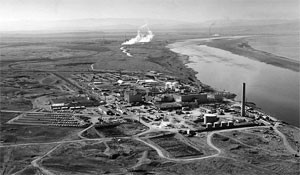 May 15 marks the 20th anniversary of a state-federal agreement to clean up the Hanford site in south-central Washington. During the Cold War, Hanford produced most of the weapons-grade plutonium for the US nuclear arsenal—and as a result, the site remains contaminated with an incredible volume of high-level nuclear waste.
May 15 marks the 20th anniversary of a state-federal agreement to clean up the Hanford site in south-central Washington. During the Cold War, Hanford produced most of the weapons-grade plutonium for the US nuclear arsenal—and as a result, the site remains contaminated with an incredible volume of high-level nuclear waste.
To mark the upcoming anniversary of the Hanford cleanup agreement, the US Department of Energy has compiled a list of its accomplishments.
Yet there’s a tremendous amount of unfinished business at Hanford. The Washington Department of Ecology still calls Hanford “the most contaminated site in North America.” And as this article, published recently in Remediation Journal, points out, the Hanford cleanup effort remains riddled with problems. (Full disclosure: John Abbotts, a longtime friend of Sightline, is one of the article’s authors, and also provided information for this blog post.)
Some 50 million gallons of highly radioactive liquid wastes are still being stored at the site, contained (for now, at least) in more than 100 underground tanks that have already exceeded their design lifespans. A facility designed to stabilize and solidify the Hanford tank wastes is now 8 years behind schedule and about $8 billion over its initial budget. And the Department of Energy’s cleanup effort is underfunded: at the end of 2007, projected budgets over the next 10 years were expected to fall $5 billion short of the funding needed to meet the deadlines set by the state-federal cleanup agreement.
To make matters worse, Bush administration proposals could have brought even more waste to the site, including waste from new facilities, waste from commercial atomic reactors, and “mixed” chemical and radioactive wastes from other Department of Energy locations across the country. This last proposal sparked Washington’s Initiative 297, which attempted to prohibit future waste imports to Hanford until Energy cleaned up all existing waste—an initiative that passed with a record 69% approval from voters in 2004.
But in May 2008, a federal appeals court found that federal law preempted the initiative. In a legal settlement, the US Department of Energy has agreed to limit the import of new wastes to Hanford until it completes a new environmental impact statement and issues a formal “record of decision” on that statement. But once Energy reaches that goal, it could start transferring additional nuclear waste to Hanford.
The Obama administration has pledged more funds to cleanup Hanford as part of the economic stimulus package — but even with the stimulus funds, cleanup won’t be completed for decades. Moreover, the new administration has not yet reversed the Bush administrations proposals for more waste at Hanford.
So 20 years into the Hanford cleanup, we’re still saddled with a toxic legacy that’s proven surprisingly difficult and expensive to clean up. To move forward — and just as importantly, to make sure we don’t create new Hanfords in the future — there remains a great need for public awareness of the project. Let’s just hope that our attention doesn’t wander — 20 years is an awfully long time to stay focused, even on a contamination problem as severe as Hanford’s.









Georgie Bright Kunkel
For many years I supported groups that worked for Hanford cleanup.However, the phony war in Iraq and Afghanistan and the fear of future terrorism took the money that is now contributing to the depression around the world.After everyone finally looked up to see what happened, we are now marching for health care and all the other people issues that were put on hold for many years. But the money to pay for it has already been promised with interest for the cost of past wars. Too bad that more people didn’t rise up during the money wasting fiasco that happened while we were sitting glazed and afraid in front ofunregulated TV. The administration for years looked the other way when protections of our safety were being overlooked. Now we must batten down the hatches, as it were, and get ready for a much simpler life without all the frills and techie gadgets that we previously went into debt to pay for. Perhaps in a way, this is a good thing. Maybe it is time to sit down in our living rooms with our families and talk again and play games and appreciate each other instead of spending all our lives text messaging our time away.
Bob dinkleman
to: GEORGIE BRIGHT KUNKELand you say that while your on the computer? you’re “wasting your life away” researching hanford. think about what you say before you say it.